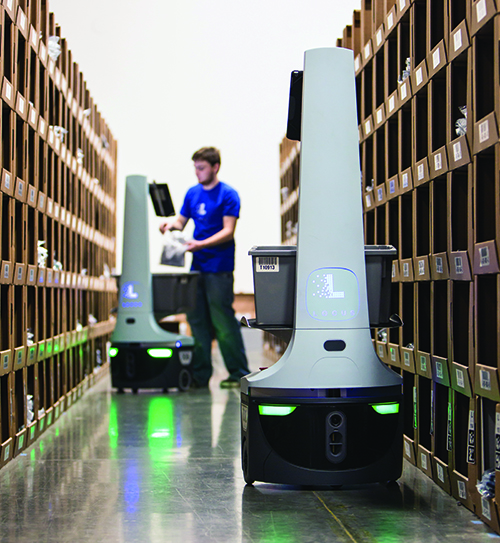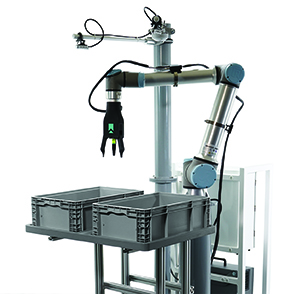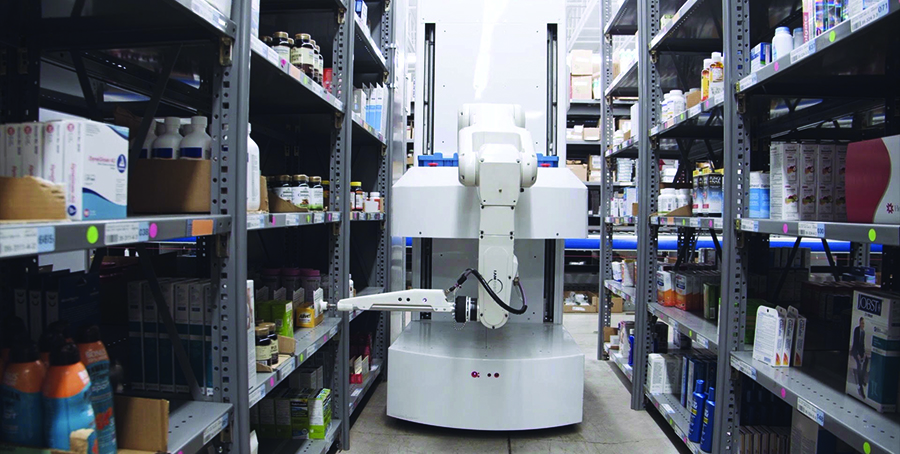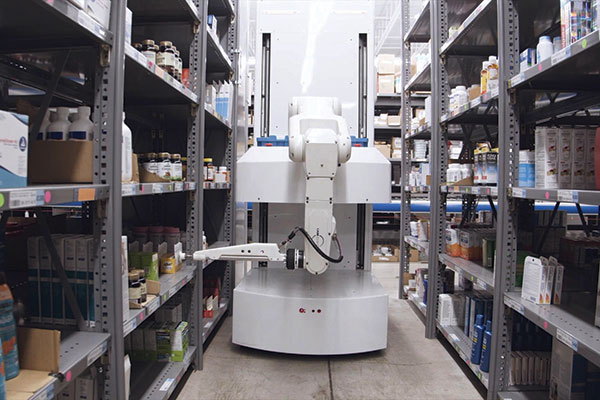In the spring of 2016, I drove to Devens, Mass., to see something truly new in the post-Kiva era: Autonomous mobile robots in a production setting at a Quiet Logistics e-fulfillment distribution center. Locus Robotics, the startup company founded by Bruce Welty and Mike Johnson, was still more concept than commercial product, but even then, Welty envisioned a multi-billion-dollar business for autonomous mobile robots (AMRs) in the warehouse. A little over a year later, I had the opportunity to watch another first: a mobile piece-picking robot from IAM Robotics at work at Rochester Drug’s distribution center in New York.
While the two robots were filling orders in very different ways, what they shared was integration: In both instances, the robots were integrated with a warehouse management system (WMS) that directed their tasks as if the robots were associates on the floor. That certainly made sense in the case of Rochester Drug, since IAM’s robot was picking to a tote in the same pick module as associates. And it also made sense at Quiet, given the principals’ experience in the WMS industry. And if you think about it, an AMR’s movements aren’t all that different from a warehouse associate pushing a cart from pick location to pick location to retrieve the items needed to fill an order.
 By the fall of 2017, when I had the chance to hear a presentation by DHL’s Adrian Kumar and Justin Ha at Dematic’s annual conference in Park City, things were changing. DHL was working with Locus to develop software to optimize the deployment of robots around a group of orders, much like the work execution systems we highlighted in the February Special Report in Modern.
By the fall of 2017, when I had the chance to hear a presentation by DHL’s Adrian Kumar and Justin Ha at Dematic’s annual conference in Park City, things were changing. DHL was working with Locus to develop software to optimize the deployment of robots around a group of orders, much like the work execution systems we highlighted in the February Special Report in Modern.
Just like the tug of war between automation and WMS companies over where order fulfillment intelligence should reside in the WES space, “I think you’re going to see a tug of war with the WMS and AMR vendors over where that intelligence should live,” predicts Peter Blair, the vice president of marketing for Berkshire Grey, a provider of robotic piece picking and sortation solutions and mobile robots. In fact, there’s already some cross-over with Softeon, Lucas Systems and Vargo Solutions developing functionality to optimize a fleet of robots like they would optimize a cadre of associates. “When it comes to work optimization, the WES is especially well suited to medium automation solutions, where you’re using putwalls, smart carts and robotics,” notes Dan Gilmore, Softeon’s chief marketing officer.
Softeon demonstrated its capabilities at ProMat last April and Vargo’s WES manages execution of robotic putwalls in several retail e-commerce facilities. “The goal is to integrate AMRs and robotic putwalls into the workflow because they’re performing with people,” notes Art Eldred, a client executive with Vargo Solutions. That tug of war may be won by the emergence of edge technology, where analysis and decision-making takes place on the floor where work is being executed. This is also referred to as edge computing.
Here’s a look at how the software systems controlling robotics in the warehouse and distribution center are evolving and the two different approaches robotics companies are taking.
Robotic execution system
We’re not sure if robot execution system, or RES, is an accepted industry term, but without question it describes an approach that’s emerging in the autonomous mobile robot market right now. And, given that optimizing a fleet of mobile robots is similar to optimizing people, RES solutions are operating much like the work execution systems emerging from companies like Honeywell, Zebra, Lucas and Softeon.
Piece picking status quo
 While something resembling a warehouse execution system is taking shape in the autonomous mobile robot world, piece picking robots have more in common with a stationary associate at a goods-to-person workstation than an AMR.
While something resembling a warehouse execution system is taking shape in the autonomous mobile robot world, piece picking robots have more in common with a stationary associate at a goods-to-person workstation than an AMR.
In goods-to-robot picking, like goods-to-person picking, the robotic arm is stationary, which means it doesn’t have to determine the most efficient travel path to get the job done. What’s more, when it’s picking items from a donor tote to an order tote, the robot just has to get the job done, the same as an associate at the workstation.
As such piece-picking robotic solutions like those coming from RightHand Robotics and Berkshire Grey rely on a WMS to generate picking tasks. The robot operating system’s job is to determine the best way to grasp the item, much like a warehouse control system that tells a conveyor to convey or a sorter to sort. “If you think of something like package sortation, where you’re moving the work through as fast as possible, there aren’t a lot of opportunities to make decisions,” notes Peter Blair, vice president of marketing for Berkshire Grey.
The ROS can contribute to the overall flow. For instance, if the robot was unable to pick an item, the WES can route a tote to another station staffed by an associate to complete the pick, or, if the required item was missing from the tote, someone in replenishment can address the issue.
“That way, instead of the tote just sitting there, you’ve automated the resolution process so the robot can keep working,” says Vince Martinelli, RightHand’s head of product marketing.
Similarly, the robot can pick items in a sequence that will optimize an operation further down the line. “If a robot is sorting items to a cubbie in a putwall, it can convey to the unit sorter if it is overloaded so that the sorter can send items to another location and smooth out the work,” notes Blair.
The robot operating system also has a machine learning role. Data about how long it takes the robot to pick various items, or items it frequently mispicks, can be analyzed to improve operations. Mispicked items might require a different tooling, for instance. Similarly, applying the characteristics of packages that are easy to pick to other items can drive down the cost per unit picked. “You can design packaging to be robot friendly,” Martinelli notes.
As companies begin to think about Big Data and Artificial Intelligence, Martinelli believes there may be an opportunity for a “core data proposition,” that utilizes the data collected by the robots elsewhere in the supply chain. “However, that requires getting a lot of systems in. If you only have one robot operating, there’s limited data,” he adds. “The company that is first to get 1,000 robots installed is going to have a leg up because of the data.”

Like the WES in automated facilities, robot execution systems (RES) are planning waves and optimizing order fulfillment.
So, how is this space changing? Let’s start with where things were. Several layers of software create a robotic solution. The first layer is the robot operating system, or ROS, which is largely related to navigation, localization and travel, much like a warehouse control system controls a conveyor or sorter.
On top of that, the robot is continually observing warehouse conditions that might impact how it gets from Point A to Point B and learning from recently completed routes.
“The robot is always making mental notes about the warehouse conditions so on its next trip, it might try a different route,” says Karen Leavitt, chief marketing officer for Locus Robotics. If you have more than one robot, they are sharing that information with the central server, much the way drivers are sharing real-time information with Waze. A larger point: Putting intelligence and decision making on the robot, or edge computing, makes this possible.
Navigation and operational functions have always been part of the package. What’s evolving is the software related to order fulfillment activities. Early on, AMR providers like Locus executed tasks in a serial fashion. An AMR received an order from the WMS, went to a pick location where an associate picked the order, and then the AMR either went to the next pick or back to the pack station when an order was picked complete.
It was similar to how an associate pushing a cart picks orders. Over time, a new approach emerged. “Rather than spread work across the warehouse, we concentrated the work in one part of the warehouse and pulled it through, increasing the density of the picks,” Leavitt says.
To optimize the process, the robot execution system analyzes a wave of orders from the WMS and creates work based on several factors:
How much work can go onto a single robot? A pool of 10,000 orders, for instance, might have 1,000 orders for cosmetics and with the right tote, a single robot can handle 15 orders.
What’s the physical proximity of SKUs? The system isn’t looking for common SKUs in an order, but SKUs that are clustered near one another, especially if other robots and people are nearby. “We want to flood the zone with as many robots as possible,” Leavitt says.
What’s the most efficient path? Once a batch of work has been assigned to a robot, or a fleet of robots, the system determines the most efficient pick path, adjusting on the fly as information from other robots is reported. And, it now does this by figuring out how to optimally deploy a fleet of robots, typically with a ratio of three or four robots per worker. By deploying a fleet, the robots are decoupled from the worker, which cuts down on the amount of walking required of associates.
IAM Robotics, which makes mobile piece picking robots that do not require a human partner, similarly optimizes a batch of orders underneath a WMS. “If we get a wave of orders involving items that are stocked in more than one place, the system can parse the tasks out across a fleet of robots,” says Wes Reid, senior product manager. “One robot may only pick certain parts of multiple orders. Underneath, there’s a lot of real-time, robot-to-robot communication. A robot in a specific aisle knows where every SKU that is pickable is located. It can tell the other robots, for instance, that it’ll pick up the package of deodorant that’s required in the wave.”
Other AMR providers are combining a robot execution system with functionality to manage people on the floor, like a work execution system. “Robots can handle about 80% of the items in a distribution center. For the other 20%, it’s more efficient to have people do that,” explains Lior Elazary, co-founder and CEO of inVia. “The system can now route a lift truck driver to get a pallet for the pallet area; route a cart runner who is delivering carts to the picking or packing areas; or direct a person in the pallet pick area.”
There’s a platform for that
At a recent industry meeting, the discussion turned to robotics. One participant remarked that his company was piloting a number of different robotic solutions, trying to determine the best fit for the organization.
“The problem is that every robotic solution provider has their own proprietary operating system and API,” he said. “You’d think someone would develop a platform that you could just plug into.”
That problem is behind the solution developed by SVT Robotics, which A.K. Schultz, the company’s CEO, describes as an “integration-platform-as-a-service.” He likens what the company is trying to accomplish to the development of the two-pronged plug that allows you to plug any electrical device into an outlet to access the grid, and the USB that allows you to plug in computer peripherals.
“We set out to create that same kind of connectivity,” Schultz explains. “Instead of enterprise systems communicating with unique or proprietary systems, you can adopt any robotics or automation technology that is integrated on the platform. And, it decouples issues around upgrades and security.”
Such a platform creates the opportunity for an ecosystem of microservices, or apps, that an end user can download to create a solution tailored for their facility. It’s similar to downloading apps onto your smart phone.
“An AMR integrates pretty easily in a warehouse,” Schultz notes. “But, what if you want to add a shuttle system, an AutoStore, a piece-picking robot or an IAM Robotics area? Right now, those are each deployed as point solutions. Down the road, they can be deployed together.”
The system is also capable of creating a profile of individual workers based on their mistakes. “The system can take into account all of the resources in the facility, from the robots to the people to the conveyors,” Elazary says. “We can then assign workers to specific jobs to take advantage of their strengths, or to give them relief.”
Core competency
Not all robot suppliers are tackling order optimization. Fetch Robotics, with one of the broadest solution portfolios in the autonomous mobile robot space, is taking something akin to a core competency approach: We’ll concentrate on what we do best, which is navigation and optimization of the fleet, and let the WMS or WES do what they do best, which is wave and batch planning.
“From my perspective, it’s not natural for a robotic system to move upward to manage the data,” says Stefan Nasser, Fetch’s vice president of product management. “What’s natural for us is to optimize the integration so that it’s easy for the WMS to leverage the data that the robot is collecting.” The WMS, he adds, is aware of spatial relationships such as the aisles and the locations of inventory in shelves and racks.
What it doesn’t know is distance, traffic congestion and the current status of people on the floor. “We can look at traffic and congestion for more efficient path planning when we get a wave of orders,” Nasser says. “This is a level of real-time data that isn’t visible to the WMS.”
Nasser thinks of this data sharing as “closing the loop” between the robotic system and the WMS. In another example, Fetch robots are scanning RFID tags throughout the warehouse to create a visual map of where things are and whether they have moved. “Because we handle pallets, cases and items in the cases, we’re collecting operational data that can give the WMS and the customer a more detailed visual impact of the warehouse,” he says.
Waypoint Robotics, another supplier of AMRs, is taking a completely different approach, focusing on solutions for what CEO Jason Walker describes as the “difficult environments” that represent the largest part of the U.S. manufacturing base—old machine shops and plants where the machines don’t move and the work changes daily or weekly, as do the traffic patterns.
Those facilities may not have a WMS or even Wi-Fi and are struggling to find enough employees to staff their operations in a tough labor market. “We designed a mobile robot that can not only work in those environments, it can be set up and configured by the people who are working there now, without a roboticist on staff,” says Walker.
To make that happen, 100% of the sensors, intelligence, algorithms and computational power are self-contained on the robot. “It will connect to the Internet if you want,” Walker notes, “but it doesn’t have to in order to do its job.” Once the robot understands the layout of the facility, associates can determine where to send it from a screen. For companies that do want to automate processes, the robot can integrate with an enterprise resource planning (ERP), warehouse execution system (WES), WMS or manufacturing execution system (MES) solution. “We don’t have that data onboard,” Walker says. “The system is designed for interoperability so that when the system calling the shots calls a shot, the robot can execute the task.”
This space is still evolving, and, as Berkshire Grey’s Blair noted earlier, there is a tug of war over who will be responsible for order optimization. And, it may not be an either/or situation: Depending on the company and its underlying system of record, it may be a robot execution system, it may be a WMS, it may be a warehouse execution system or it may be a work execution system. If there’s anything certain at all, it’s that robot software systems will play a more important role in the future.
Companies mentioned in this article:
- Berkshire Grey
- Fetch Robotics
- IAM Robotics
- inVia
- Locus Robotics
- RightHand Robotics
- Softeon
- SVT Robotics
- Vargo Solutions
- Waypoint Robotics
About the Author
Follow Robotics 24/7 on Linkedin
About the Author
Follow Robotics 24/7 on Linkedin
Article topics
Email Sign Up

















